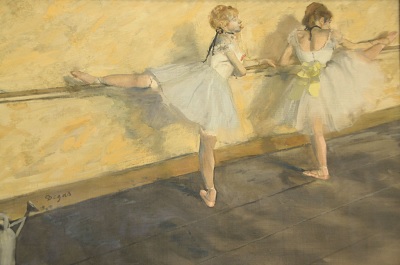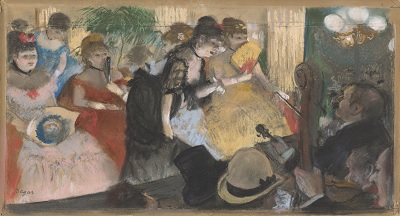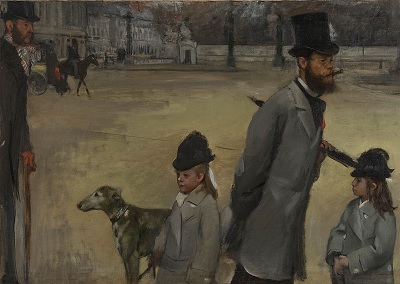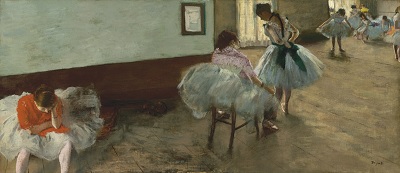Paintings
Artist Edgar Degas had a unique style which sat somewhere between Impressionism and Realism. His paintings remain amongst the most loved in all of art history.
The Degas family had a background in the banking industry but Edgar’s passion was art, and art only. He was fortunate in being able to concentrate entirely on this right across his career, possibly to the detriment of his personal life. He never married. The images of his work that you will find below provide examples of cutting edge impressionism and realism, which helped to shape the future of European art. Degas was your talented but sometimes brash and unwelcoming artist. He was someone you would always respect, but not necessarily like in a social sense.
Degas was trained in the classical artistic styles and also appreciated such work on a personal level. Much of his early work went along a similar path as he set about learning more bout himself and understanding what style he preferred for his own work. The key influences on Degas at this stage would be Manet and Ingres. This was an artist who would cover all main themes during his career, including facial portraits, landscapes and full length anatomical studies. There was an uncertainty in France during the early years of his life and this was matched by an art world which was enjoying new influences. Impressionism was to build momentum, with Degas a key figure. His slightly different style and opinionated character meant his relationship with other impressionists was rarely comfortable. In the 1890s Degas took a new direction in his work, concentrating entirely on landscape painting for several years. This followed a fallow period where the artist had clearly been introspecting over a possible new series of work that could inspire him once more.
Some say his inspiration for these scenes came from train journeys, from where he would view some stunning French countryside. Many will make immediate comparisons with the work of Claude Monet, both in terms of colour and composition. Degas frequently reduced detail and ‘clutter’ to an absolute minimum. A desire to distance himself from the likes of Monet did not translate as a disliking for his work. On the contrary, the influence of Monet is clear to see within this period of his life. Whilst Monet would often work plein-air, memory was key to Degas’ landscapes. He would retire to his studio with scenes clearly laid out in his mind from earlier trips. Ingres had indeed advised this course of action to him as a budding student.

Ballet Class

Dance Class

Blue Dancers

Green Dancer

Bellelli Family

At the Races

Absinthe

Racehorses in a Landscape

The Bath

The Tub

The Dancing Class

After the Bath, Woman Drying Herself

Ballet Rehearsal

A Cotton Office in New Orleans

The Blue Dancers

The Dance Foyer at the Opera on the Rue le Peletier

The Millinery Shop

Dancers on the Stage

Dancers at the Barre

The Ballet Rehearsal on Stage

The Rehearsal of the Ballet on Stage

Young Spartans Exercising

Dancers Practicing at the Barre

Interior

Scene of War in the Middle Ages

Orchestra Musicians

The Orchestra at the Opera

At the Café-Concert

At the Milliner’s

Dancers in Pink
A Woman Seated beside a Vase of Flowers

Miss La La at the Cirque Fernando

Dancer in Front of a Window

Place de la Concorde

Waiting

Portraits at the Stock Exchange

The Dance Lesson

Women Ironing

The Star (Dancer on Stage)

Dancer Tilting

Seated Dancer

Dancer Resting

The Fallen Jockey

Two Dancers on Stage

Combing the Hair

The Singer in Green

Dancer with Bouquet

Portrait of a Young Woman

A Roman Beggar Woman

Giovanna and Giulia Bellelli

Self Portrait in a Soft Hat

Three Dancers in an Exercise Hall

Three Ballet Dancers

Dinner at the Ball

Dancer in her Dressing Room

The Star – Dancer on Pointe

The Rehearsal

Dancer with Bouquet (1877)

Racehorses at Longchamp

Madame De Rutte

At the Stables, Horse and Dog
Elena Carafa

The Pedicure

The Dance Class (1873)

Dance Opera

Dancers Backstage

Dance Class at the Opera

Ballet Scene from Robert la Diable

General Mellinet and Chief Rabbi Astruc

Dance Class (1871)

Madame Camus with a Fan

M. And Mme Edouard Manet

Madame Gobillard, Yves Morisot

Mlle Fiocre in the Ballet The Source

Semiramis Building Babylon

Portrait of James Tissot

Mademoiselle Fiocre in the Ballet

Head of a Young Woman

Self Portrait Saluting

Edmond and Therese Morbilli

The Start of the Hunt

Edmondo and Therese Morbilli

Alexander and Bucephalus

Portrait of a Lady in Grey

Therese Degas, Sister of the Artist, Later Madame Edmond Morbilli

On the Racecourse

Little Girl Carrying Flowers in her Apron

At the Races – The Start

The Crucifixion (After Mantegna)

Two Riders by a Lake



